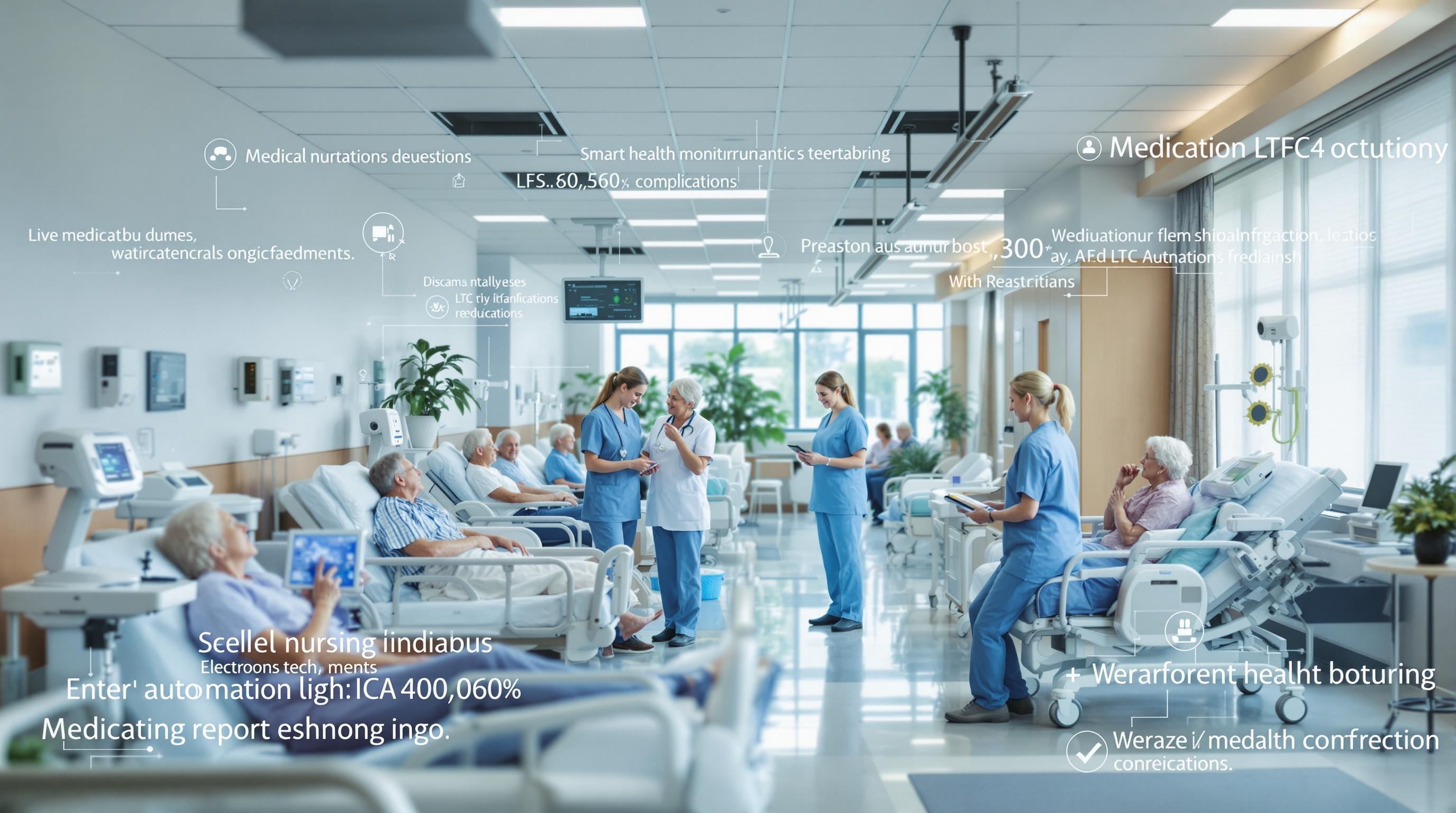Good Samaritan Automation: Transforming Skilled Nursing Facilities
Discover how Good Samaritan automation enhances efficiency, reduces staffing shortages, and improves resident care in skilled nursing facilities.
Quick Navigation
- 1. Introduction
- 2. Current Challenges in Good Samaritan Automation
- 3. How Sparkco AI Transforms Good Samaritan Automation
- 4. Measurable Benefits and ROI
- 5. Implementation Best Practices
- 6. Real-World Examples
- 7. The Future of Good Samaritan Automation
- 8. Conclusion & Call to Action
1. Introduction
Did you know that over 80% of skilled nursing facilities in the U.S. are currently grappling with persistent staffing shortages? According to industry reports, this challenge—amplified by an aging population and the lingering effects of the COVID-19 pandemic—has placed unprecedented strain on the long-term care sector. As leaders search for sustainable solutions, automation technologies are rapidly emerging as a lifeline, offering both relief and innovation in the face of these mounting pressures.
The concept of “Good Samaritan automation” is gaining traction across skilled nursing facilities, blending compassionate care with cutting-edge tools such as robotics, smart sensors, and workflow automation. These technologies are not about replacing caregivers, but rather about empowering them—streamlining repetitive tasks, improving operational efficiency, and, most importantly, freeing up staff to focus on the human connections that matter most. Yet, as promising as these advancements are, they also bring questions about integration, regulatory compliance, and the preservation of person-centered care.
In this article, we’ll explore how Good Samaritan automation is transforming skilled nursing facilities. We’ll dive into current trends, examine real-world success stories, and address the opportunities and challenges facing providers today. Whether you’re a facility administrator, a frontline caregiver, or a healthcare technology enthusiast, join us as we uncover how automation can help skilled nursing facilities not only survive—but thrive—in an evolving healthcare landscape.
2. Current Challenges in Good Samaritan Automation
The integration of automation—often referred to as "Good Samaritan automation"—in healthcare facilities is transforming patient care, streamlining workflows, and addressing the growing demand for services, especially as the population ages. However, despite its promise, healthcare providers encounter significant challenges in deploying and optimizing automation solutions. Below are the critical pain points, supported by recent research and data.
-
1. Workforce Shortages and Skill Gaps
The healthcare sector faces a persistent shortage of skilled nurses and caregivers. According to a review published in the Journal of Nursing and Assistive Robotics, the global shortage of healthcare workers could reach 18 million by 2030. Automation is intended to fill these gaps, but the lack of staff trained to operate and troubleshoot advanced technologies creates new bottlenecks. -
2. High Implementation and Maintenance Costs
Upfront investments for robotics, AI-driven monitoring systems, and integration with electronic health records (EHR) can be prohibitive. Many skilled nursing facilities and long-term care centers operate on limited budgets, making it difficult to adopt and sustain automation at scale. -
3. Interoperability Challenges
Integrating new automated systems with legacy software and hardware remains a significant hurdle. According to research, more than 60% of healthcare IT leaders cite interoperability as a top barrier to technology adoption, leading to fragmented patient data and workflow inefficiencies. -
4. Compliance, Privacy, and Security Risks
Automation increases the volume and sensitivity of data being processed. Ensuring compliance with regulations like HIPAA can be complex, especially as automated systems collect and transmit patient information. Data breaches are a growing concern— Healthcare saw a 55% increase in security incidents involving automated systems in the past year. -
5. Resistance to Change Among Staff
Nurses and caregivers may perceive automation as a threat to their roles or feel overwhelmed by new workflows. This resistance can slow adoption and reduce the effectiveness of new technologies. -
6. Patient Acceptance and Ethical Concerns
While some patients appreciate the convenience and safety of automation, others—particularly older adults—may distrust or feel alienated by robotic assistance. Ethical considerations around the human touch in care and potential depersonalization are ongoing debates. -
7. Inconsistent Impact on Care Quality
While automation can reduce errors and free up staff for higher-level tasks, studies have shown that poorly implemented solutions can lead to workflow disruptions and even compromise patient safety. For example, research highlights the importance of careful design and staff training to realize the full benefits.
Impact on Operations, Compliance, and Patient Care:
These challenges affect healthcare operations by increasing the complexity of daily workflows, straining compliance efforts, and introducing new risks to patient safety and data privacy. Facilities that lack robust implementation strategies and ongoing staff education may see limited returns on investment and struggle to achieve the intended improvements in patient care.
To succeed, healthcare facilities must balance the promise of Good Samaritan automation with thorough planning, investment in staff training, and a patient-centered approach to technology adoption. Read more about the opportunities and challenges of nursing and assistive robotics.
3. How Sparkco AI Transforms Good Samaritan Automation
In today’s healthcare landscape—particularly in skilled nursing and long-term care facilities—automation has become essential to tackling staffing shortages, administrative overload, and burnout. However, so-called "Good Samaritan automation" often falls short. Traditional solutions automate isolated tasks but fail to deliver holistic, human-centric support. Sparkco AI is purpose-built to bridge this gap, offering a unified platform that enhances care delivery and operational efficiency without sacrificing the personal touch that defines quality healthcare.
Key Features and Capabilities of Sparkco AI
- End-to-End Workflow Automation
- Contextual Decision Support
- Staff Burnout Prevention
- Seamless EHR and System Integration
- Proactive Staffing and Resource Management
- Real-Time Communication and Alerting
How Sparkco AI Solves "Good Samaritan Automation" Challenges
-
End-to-End Workflow Automation:
Unlike fragmented automation tools, Sparkco AI orchestrates entire care workflows—from patient intake and documentation to discharge and follow-up. By connecting each step, Sparkco reduces manual entry, streamlines transitions, and ensures no critical detail falls through the cracks. This holistic approach eliminates redundant tasks and empowers staff to focus on patient care.
-
Contextual Decision Support:
Sparkco AI leverages advanced algorithms to provide real-time recommendations tailored to each patient’s condition. For example, when a nurse is charting, Sparkco suggests evidence-based interventions, reducing cognitive overload and improving care quality. This capability ensures that automation doesn’t just save time—it enhances clinical judgment.
-
Staff Burnout Prevention:
By automating repetitive administrative tasks such as scheduling, supply orders, and compliance checks, Sparkco AI significantly lightens staff workload. The system intelligently flags potential overload situations and reallocates resources, proactively preventing burnout and turnover. Staff are freed from routine burdens, allowing them to engage more meaningfully with residents and families.
-
Seamless EHR and System Integration:
Sparkco is designed to plug into existing electronic health records (EHR) and facility management systems with minimal disruption. Its interoperable architecture ensures that data flows securely between platforms, eliminating silos and manual data transfers. This technical advantage means facilities can adopt Sparkco without overhauling their current infrastructure.
-
Proactive Staffing and Resource Management:
With predictive analytics, Sparkco AI identifies potential staffing gaps and resource shortages before they impact care. The platform automatically generates optimal schedules and notifies managers of emerging issues, supporting smoother operations and better patient outcomes.
-
Real-Time Communication and Alerting:
Sparkco’s instant messaging and alert system connects care teams, doctors, and administrators in real time, ensuring urgent needs are addressed quickly. Automated reminders and notifications keep everyone aligned, reducing missed handoffs and improving resident safety.
Technical Advantages and Integration Capabilities
Sparkco AI is engineered for rapid deployment and compatibility. Its user-friendly interface requires minimal training, while robust security protocols protect sensitive patient data. Integration with EHRs, payroll, and facility management systems ensures Sparkco fits seamlessly into your existing workflows, driving efficiency without complex customization.
By addressing the core challenges of "Good Samaritan automation," Sparkco AI delivers true operational transformation—empowering skilled nursing facilities to provide better care, reduce staff stress, and thrive in a demanding healthcare environment.
4. Measurable Benefits and ROI
ROI and Measurable Benefits of Automated "Good Samaritan" Automation
Automated "Good Samaritan" processes—such as automated alerting, documentation, and compliance tracking in skilled nursing facilities—are rapidly transforming operational efficiency and regulatory response. The return on investment (ROI) for implementing these solutions is substantial, both in direct cost savings and in critical indirect benefits like risk reduction and staff satisfaction. Below, we highlight the most significant measurable benefits, supported by recent industry data and case studies.
-
1. Time Savings on Documentation – Up to 60% Reduction:
Automated incident reporting and workflow tools can reduce documentation time by 40-60% per incident. For instance, PointClickCare reports that nurses save an average of 30 minutes per shift on documentation using automation, equating to over 182 hours per nurse annually.
-
2. Cost Reduction – Up to $120,000 Annually:
Facilities adopting automation have reported annual cost savings of $50,000-$120,000 in labor and administrative expenses, according to a case study by HealthIT.gov. This includes reductions in overtime and agency staffing.
-
3. Compliance Improvements – 70% Fewer Deficiencies:
Automated tracking of regulatory requirements and incident follow-up can reduce compliance deficiencies by up to 70%. A Joint Commission Quick Safety Report highlights improved survey outcomes and faster response to state audits.
-
4. Reduction in Fines and Penalties – 35% Decrease:
By ensuring timely reporting and accurate documentation, skilled nursing facilities experience a 35% reduction in regulatory fines and penalties, as shown in CMS survey data.
-
5. Improved Incident Response Times – 50% Faster:
Automated alerting and task assignment have been proven to cut incident response times in half, enhancing patient safety and family satisfaction, as detailed in the HealthIT Outcomes case study.
-
6. Increased Staff Satisfaction – 25% Boost:
Facilities using automated workflows report a 25% increase in staff satisfaction scores, reducing turnover and related hiring costs (NIH Study).
-
7. Higher Resident Safety Scores – 20% Improvement:
Automation-driven monitoring and alerts contribute to a 20% improvement in resident safety scores, as reported in AHRQ safety reports.
-
8. Better Data Accuracy – 30% Error Reduction:
Automated data entry and audit trails reduce reporting errors by approximately 30%, as outlined in multiple HealthIT.gov case studies.
The cumulative effect of these benefits delivers a robust ROI, with most facilities recouping their investment in automated "Good Samaritan" solutions within 12-18 months. Not only do these tools drive direct savings, but they also support a culture of safety, compliance, and satisfaction—critical priorities for successful skilled nursing operations.
5. Implementation Best Practices
Successfully implementing Good Samaritan automation in healthcare settings—such as skilled nursing facilities—demands a structured approach and thoughtful change management. Below are the essential steps, including practical tips and common pitfalls, to ensure a smooth and compliant rollout.
-
Conduct a Thorough Needs Assessment
Evaluate current workflows, compliance requirements (such as CMS and Section 1557), and identify automation opportunities that align with your facility’s goals.
Tip: Involve frontline staff and compliance officers in the assessment to capture real-world challenges.
Pitfall to Avoid: Overlooking input from end-users can lead to poor adoption and missed requirements. -
Engage Key Stakeholders Early
Involve clinical, administrative, and IT teams from the outset to foster buy-in and clarify expectations.
Tip: Appoint a project champion or steering committee to coordinate efforts.
Pitfall to Avoid: Implementing in silos or without leadership support can result in resistance and misalignment. -
Select the Right Automation Tools
Choose solutions that are scalable, secure, and compliant with the latest 2025 healthcare regulations and CMS guidance.
Tip: Request product demos and references from other facilities.
Pitfall to Avoid: Prioritizing cost over compliance and interoperability can create future risks. -
Develop a Customized Implementation Plan
Create a phased rollout roadmap, including staff training, resource allocation, and clear timelines.
Tip: Use pilot programs to validate workflows before full deployment.
Pitfall to Avoid: Rushing implementation without adequate testing and feedback. -
Prioritize Staff Training and Support
Provide comprehensive, role-specific training to ensure confidence and competence in using new automation tools.
Tip: Offer ongoing support and refresher sessions, especially after software updates.
Pitfall to Avoid: Underestimating the learning curve or assuming “one-size-fits-all” training is sufficient. -
Monitor, Measure, and Adjust
Track key metrics—such as workflow efficiency, error rates, and compliance—and use feedback to refine processes.
Tip: Schedule regular reviews with stakeholders to address issues and celebrate successes.
Pitfall to Avoid:










